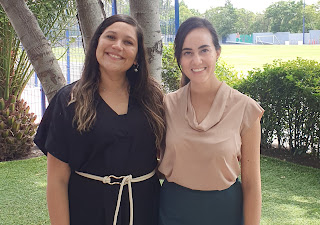Padres en la adolescencia: Construyendo puentes de comunicación, Fernanda Covarrubias y Rocío Aguirre, MS Counselors
On September 7Tth, our Middle School Psychologists, Rocío Aguirre and María Fernanda Covarrubias, gave conference for the 6th grade parents titled “Parents in adolescence: building bridges of communication.” With the objectives to be identify by them and, to support them in this new beginning.
We’d like to share with you a brief article prepared by them, about the most relevant points of their talk.
Conversations with teenagers
At around age eleven, kids begin the normal and necessary work of pulling apart from their parents. As they set their feet on the long path to adulthood, the first and most important thing they do is to establish their own identity. This means figuring out who they are apart from you.
It is a time where young people take a chance
to figure out their own styles, values, interests, and beliefs.
It is difficult for parents because it can
still feel like rejection and it is natural that you´ll want to protect and
support them through it all.
Supporting and protecting are hard to do when
kids become tweens, because one of the first things they often do is shut down
communication. Parents, often blindsided by this, turn up the volume. They´re
reduced to saying the same thing over and over again, increasingly more slowly,
and loudly with every iteration.
So how do we reconcile a tween´s need to
separate from us with our parental desires and obligations to keep them safe,
smart and connected?
We learn to speak a new language. Talk with them. Not to them or at them, but
with them.
When parents can see risky behavior, they try
to monitor their conduct: track their social media or conversations, ground
their son and keep him home where they can always keep an eye on him and they
sacrifice conversations “with” them.
Sometimes making your middle schooler´s world
smaller is the best way to keep them safe. They need discipline and boundaries.
But sometimes parents resort to the “shut it down” approach because they don't
feel there are other viable options.
The best thing parents can do is trust their
kids to make smart decisions. They won't learn how to make smart decisions if
we deny them the opportunity to make any decision. Parents should teach to
evaluate, process and reflect on what works and what doesn't. That only happens
through conversations.
Experiences + conversation: powerful learning.
Keeping kids safe is all about having the right conversations at the right time.
If parents are waiting to catch their kid before they fall down a hole, you´re missing countless opportunities to talk about when unexpected new holes might appear and how to walk around them.
Model to have good conversations:
BRIEF
B: begin peacefully
Begin with an unemotional observation: I
see…. Like report carts came out. I saw
your grades weren’t as we expected.
Put a schedule to talk: Report cards came out
today. I think we should talk about this. Is before or after dinner better for
you?
R: relate
It is your job to teach them how to do better,
and no one learns best when they are scared and anxious and ashamed.
“It is tough when you finally have to be
honest, but I find it always feels better to stop hiding things from people who
want to help us”.
I: interview
Now that you establish yourself as an ally, or
at least an empathic authority figure. It is your turn to ask your burning
questions.
This is not the time to catch your kid in a
lie or teach them a lesson. It is a fact-finding mission.
E: echo what you´re hearing
It is validation, comprehension check, making
sure you have all the facts.
Summarize key facts, “I am hearing, it sounds like”.
F: feedback
You get to finally offer suggestions,
guidance, and make new rules.
Rocío Aguirre y María Fernanda Covarrubias
MS Coulselors
El pasado 7 de septiembre nuestras Psicólogas
de Middle School Rocío Aguirre y María Fernanda Covarrubias, impartieron una
plática a los padres de familia de 6° grado titulada “Padres en la
adolescencia: construyendo puentes de comunicación”. Esto con la finalidad de
que los padres de familia las identifiquen y sobre todo, con el objetivo de
acompañarlos en este nuevo comienzo.
A continuación, les
compartimos un breve artículo elaborado por ellas, el cual contiene de manera
general, los puntos más relevantes de su plática.
Conversaciones con
adolescentes
Alrededor de los once años, los niños
comienzan un camino normal y largo, pero necesario, hacia la adultez. A medida
que los chicos entran en la adolescencia, comienzan a distanciarse de sus
padres y establecer su propia identidad.
Esto significa descubrir quiénes son aparte de
“papá” o “mamá”. Es un momento en el que los jóvenes se arriesgan a descubrir
sus propios estilos, valores, intereses y creencias. Sin embargo, este proceso
no es sencillo para los padres ya que muchas veces, puede sentirse como un
rechazo. Además, es natural que los padres sientan la necesidad de protegerlos
y apoyarlos en todo momento; y hacerlo, se vuelve más complicado cuando los
adolescentes, lo primero que hacen, es cortar comunicación.
Entonces, ¿cómo reconciliamos la necesidad de
separarse de nosotros de un preadolescente con nuestros deseos y obligaciones
parentales de mantenerlos seguros, inteligentes y conectados?
Aprendiendo a hablar un nuevo idioma. Es
decir, hablemos CON ellos, no A ellos. Cuando los padres pueden observar comportamientos
arriesgados, buscan corregir la conducta supervisando más, castigando e
intentando mantener al adolescente bajo control; sacrificando conversaciones
“con” ellos.
Es cierto que se necesita en casa un ambiente
de disciplina y límites, sin embargo, a veces los padres sienten que es lo
único que se debe hacer, olvidando que lo mejor que los padres pueden hacer es
confiar en que sus hijos son capaces de tomar decisiones inteligentes.
¿Cómo aprende un joven a tomar decisiones
inteligentes? No aprenderán a tomar decisiones inteligentes si les negamos la
oportunidad de tomar alguna decisión.
Es importante para los padres reconocer que
los jóvenes deben vivir experiencias para a partir de ellas los padres
enseñarles a evaluar, procesar y reflexionar sobre lo que funciona y lo que no.
Es decir, mantener a los niños seguros se trata de tener las conversaciones
adecuadas en el momento adecuado. Si los padres están esperando atrapar a su
hijo antes de que caiga en un agujero, están perdiendo innumerables oportunidades
para hablar sobre cuándo podrían aparecer nuevos agujeros inesperados y cómo
evitarlos.
Es por esto que proponemos el Modelo BREVE
para generar conversaciones que lleven a aprendizajes significativos:
B: begin peacefully: Comienza con una observación
sin emociones.
R: Relate:
Para poder tener una conversación, debemos procurar un ambiente de
empatía ya que nadie aprende mejor cuando está asustado, ansioso y avergonzado.
I:Interview: Ahora que te has establecido como
un aliado, o al menos como una figura de autoridad empática, es tu turno de
hacer tus preguntas candentes.
E: Eco de lo que estás escuchando, una
verificación de comprensión. asegurándose de tener todos los hechos.
F: Feedback.Finalmente, puedes ofrecer
sugerencias, orientación y establecer nuevas reglas.
Si quieren conocer más sobre este método y el
cómo entablar conversaciones significativas con adolescentes, les recomendamos
el libro “Fourteen Talks by Age Fourteen: The Essential Conversations You Need
to Have with Your Kids Before They Start High School” de Michelle Icard.
MS Coulselors


.jpg)



Comments
Post a Comment